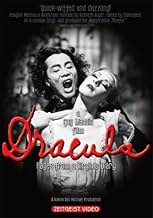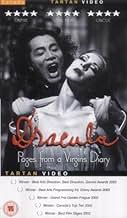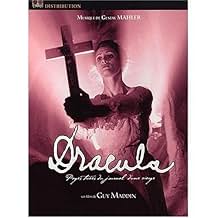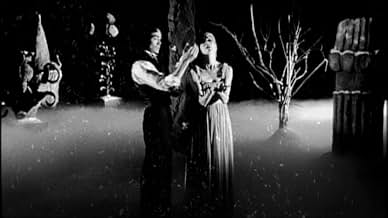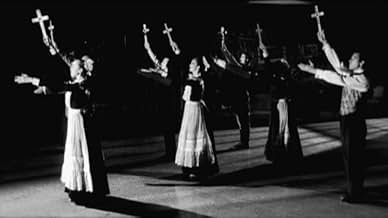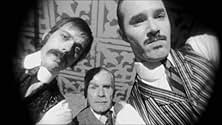Dracula, pages tirées du journal d'une vierge
Original title: Dracula: Pages from a Virgin's Diary
- 2002
- Tous publics
- 1h 13m
IMDb RATING
6.8/10
2.3K
YOUR RATING
A ballet rendition of Bram Stoker's "Dracula", stylized as an Expressionistic silent film.A ballet rendition of Bram Stoker's "Dracula", stylized as an Expressionistic silent film.A ballet rendition of Bram Stoker's "Dracula", stylized as an Expressionistic silent film.
- Awards
- 4 wins & 2 nominations total
Wei-Qiang Zhang
- Dracula
- (as Zhang Wei-Qiang)
Johnny A. Wright
- Jonathon Harker
- (as Johnny Wright)
- Director
- Writers
- All cast & crew
- Production, box office & more at IMDbPro
Featured reviews
It's definitely true that when you know absolutely nothing about this movie beforehand, it might come as a bit of a shocker. It's a ballet version of the Dracula story and if that wasn't already enough originality and strangeness, it's also shot in a silent movie style.
Actually, I already was familiar with some of Guy Maddin's other work, so I sort of knew what to expect from this movie already. He's a director that loves to shoot his movies in a very stylish and old fashioned style, often from the silent movie era. But it's not like he just mimics the style, he makes it completely his own. It's like he's always giving his own free interpretation of the genre and completely reinvents it instead. Saying that this movie is done in an old fashioned style does not mean you could compare it to older movies as well. It's very much its own thing, which is also the foremost reason why this movie works out so well.
Basically the foremost reason why this movie is such an intriguing and perfectly watchable one, are its visuals. It's a spectacular movie to look at, even though it's almost entirely shot in black & white. The camera-work is very innovative and also helps to keep the movie going at all times.
It was also quite interesting to see the familiar story being told for most part from the viewpoint of the Lucy Westernra character. This was actually a very good idea in my opinion, since her character perhaps goes through the biggest transformations and is one of the more interesting, yet mostly ignored, characters from the Dracula story.
What also was quite interesting was seeing an Asian in the role of Dracula. It sounds odd but it actually was something that worked out quite well. Wei-Qiang Zhang, as it turned out, was a very charismatic choice, for the role of the well known and much portrayed blood sucking count.
And as far as ballet goes; this movie does mostly a good job at keeping things understandable and not all about its dancing and exaggerated expressions from its actors. But I should probably say that if you aren't familiar at all with the Dracula story, you probably will still have a hard time following the story in this movie. But then again, who isn't familiar with the Dracula story now days?
I should also probably admit that if the movie would had been any longer, I would had had a hard time finishing it. The movie as it is at times feels sort of overlong already, even while its only 73 minutes short. Watching a completely silent movie, with dancing characters, gets a bit of an endurance test after a while I guess but it still remains an ultimately rewarding movie, by the end.
Visually and technically speaking, its a great and interesting, original movie, that might not keep everybody constantly interested though.
7/10
http://bobafett1138.blogspot.com/
Actually, I already was familiar with some of Guy Maddin's other work, so I sort of knew what to expect from this movie already. He's a director that loves to shoot his movies in a very stylish and old fashioned style, often from the silent movie era. But it's not like he just mimics the style, he makes it completely his own. It's like he's always giving his own free interpretation of the genre and completely reinvents it instead. Saying that this movie is done in an old fashioned style does not mean you could compare it to older movies as well. It's very much its own thing, which is also the foremost reason why this movie works out so well.
Basically the foremost reason why this movie is such an intriguing and perfectly watchable one, are its visuals. It's a spectacular movie to look at, even though it's almost entirely shot in black & white. The camera-work is very innovative and also helps to keep the movie going at all times.
It was also quite interesting to see the familiar story being told for most part from the viewpoint of the Lucy Westernra character. This was actually a very good idea in my opinion, since her character perhaps goes through the biggest transformations and is one of the more interesting, yet mostly ignored, characters from the Dracula story.
What also was quite interesting was seeing an Asian in the role of Dracula. It sounds odd but it actually was something that worked out quite well. Wei-Qiang Zhang, as it turned out, was a very charismatic choice, for the role of the well known and much portrayed blood sucking count.
And as far as ballet goes; this movie does mostly a good job at keeping things understandable and not all about its dancing and exaggerated expressions from its actors. But I should probably say that if you aren't familiar at all with the Dracula story, you probably will still have a hard time following the story in this movie. But then again, who isn't familiar with the Dracula story now days?
I should also probably admit that if the movie would had been any longer, I would had had a hard time finishing it. The movie as it is at times feels sort of overlong already, even while its only 73 minutes short. Watching a completely silent movie, with dancing characters, gets a bit of an endurance test after a while I guess but it still remains an ultimately rewarding movie, by the end.
Visually and technically speaking, its a great and interesting, original movie, that might not keep everybody constantly interested though.
7/10
http://bobafett1138.blogspot.com/
At the end of the 19th Century, immigrants come into England, not all of them gentle. One such immigrant is the evil Dracula who claims his first victim, Miss Lucy Westenra. Her three suitors call for help from Dr Van Helsing, but it is too late and she turns to vampire. They set out to kill her for good, but can they prevent Dracula claiming his next victim - Westenra's cousin Mina?
As part of my approach to films, I try to not just watch the big new releases or the well known smaller films, but I'll give things a try even if I know little about them but they sound OK. I'll admit that I have been burnt by this on many occasions but this time it worked out for the best. I'm not a big ballet fan, but I enjoyed this film as it mixed the ballet into a story that was told very easily though dance and closed captions. The fact that it was a very cinematic ballet really helped me get into it - the film's style is a homage of sorts to silent film, in it's filming, caption cards and whole look. I like this and it made it more interesting to me. Even the exaggerated looks on he casts' faces reminded me of the silent movies.
The actual ballet in the film is mixed. Some scenes are excellent and flow so very easily, the best by far being Dracula's final dance with Mina. However other parts are not so strong and the motion is not well captured by the camera, which itself seems to want to get in on all the motion and doesn't stay still long enough to really let the eye take in the movement. Happily this is the minority of the scenes as most of it is very nice to watch.
The direction of the ballet is good, but so is the direction of the film. The style captures the silent era well but also has enough clever touches in it to keep it fresh. The tinting of frames and selective use of colour make for interesting flourishes without over doing it. The cast also do reasonably well but are mixed. Zhang is magnificent in both his portrayal of Dracula and his ballet. Most of he rest of the cast do well, but only Birtwhistle (Westenra) and Moroni (Helsing) really stand out for their skills and characters. The support has no weak links in fairness and everyone does what is required of them.
The bottom line is, if you don't like ballet, then you probably won't like this film. If you do like ballet and also like cinema then you should take something from this. For me, I enjoyed the ballet as part of the story telling process but also got a kick out of seeing a silent movie version of Dracula done with modern touches.
As part of my approach to films, I try to not just watch the big new releases or the well known smaller films, but I'll give things a try even if I know little about them but they sound OK. I'll admit that I have been burnt by this on many occasions but this time it worked out for the best. I'm not a big ballet fan, but I enjoyed this film as it mixed the ballet into a story that was told very easily though dance and closed captions. The fact that it was a very cinematic ballet really helped me get into it - the film's style is a homage of sorts to silent film, in it's filming, caption cards and whole look. I like this and it made it more interesting to me. Even the exaggerated looks on he casts' faces reminded me of the silent movies.
The actual ballet in the film is mixed. Some scenes are excellent and flow so very easily, the best by far being Dracula's final dance with Mina. However other parts are not so strong and the motion is not well captured by the camera, which itself seems to want to get in on all the motion and doesn't stay still long enough to really let the eye take in the movement. Happily this is the minority of the scenes as most of it is very nice to watch.
The direction of the ballet is good, but so is the direction of the film. The style captures the silent era well but also has enough clever touches in it to keep it fresh. The tinting of frames and selective use of colour make for interesting flourishes without over doing it. The cast also do reasonably well but are mixed. Zhang is magnificent in both his portrayal of Dracula and his ballet. Most of he rest of the cast do well, but only Birtwhistle (Westenra) and Moroni (Helsing) really stand out for their skills and characters. The support has no weak links in fairness and everyone does what is required of them.
The bottom line is, if you don't like ballet, then you probably won't like this film. If you do like ballet and also like cinema then you should take something from this. For me, I enjoyed the ballet as part of the story telling process but also got a kick out of seeing a silent movie version of Dracula done with modern touches.
Quite unique and very stylish interpretation of the legendary Bram Stoker-tale, shot by one of the most gifted (yet regretfully underrated) fantasy-directors of all time; Guy Maddin. There isn't much to say about storyline, as the film loyally tells the myth of Dracula as we all know it. The originality here is Mark Godden's ballet adaptation of Stoker's novel and the fact Maddin films it as a very stylish, neo-silent play with a very limited amount of sets and a Chinese actor in the role of Dracula. Of course, several sequences have been removed in this film (like Harker's journey through Transylvania) and others have been modified (it is in fact Lucy who's the main character, not Mina) but what Maddin adds truly makes up for this. This is a very beautiful film to look at, with a staggering use of color-shades and musical guidance. I never ever thought I would say this but the ballet performances are mesmerizing and if ballet always looks like this I urgently have to attend more recitals! With his third best film to date (after "Tales from the Gimli Hospital" and "The Saddest Music in the World"), Guy Maddin brings wonderful homage to classic and silent cinema. It's really encouraging to see that films like this are still being made in this day and age. Highly recommended!
Had "Dracula: Pages from a Virgin's Diary" been made in Hollywood of with a huge budget, I don't think I would have been as favorably disposed towards the project. After all, the DVD is a bit rough here and there--credits shake a bit and a few of the computer effects (especially superimpositions) are very rough. BUT, you must realize that this is a production of the Royal Winnepeg Ballet. And, while it's a very well-respected and quality production company, it wasn't like these were seasoned filmmakers. So, I cut it a lot of slack. Based on this, it's actually a rather incredible production--with lovely sets, great costumes and a nice Gothic horror/romantic look about it. Heck, I hate opera and I still appreciated the amazing task they did in creating something like this. Probably not for everyone, but using modern dance and ballet, it does make a sophisticated art form more approachable to the masses.
What an absolute thrill, from start to finish, just experiencing the `artistic conception' of this reverent homage to silent film, featuring Canada's Royal Winnipeg Ballet, a stunning performance by Zhang Wei-Qiang as Dracula, and the brilliant production design of Deanne Rohde. Once again, Guy Maddin has created a unique, conceptualized universe all his own; there's nothing else in cinema quite like his eerie, dreamlike imagery. This film is immersed in the thundering power of Mahler's `Resurrection' 2nd Symphony, a work which itself features an ascension from all things human and earthly, and rises into the glorious heavens, a transcendent experience which, musically, grounds this film. From this theme, we add vampires, whose lust for blood promises life everlasting. The performance of Zhang Wei-Qiang dominates throughout, as he is easily the most fascinating stage personality, filled with a mesmerizing ability to seduce and ultimately possess his willing screen sirens, and while I can't speak for anyone else, I always root for him against his puritanesque nemesis, Dr Van Helsing, the leader of the repressed gang of vampire slayers. Ballet director Mark Godden choreographed the ballet adapted by Maddin for this film, so there is constant motion on screen. All this is done in image and in dance, with exaggerated gestures and with an extreme grace in movements, magnificently sensuous and macabre, shrouded in fog and black and white shadows, with only the tiniest color tints. Each frame, by itself, is a still masterpiece; the imagery is that overpowering. But when put in motion by such gifted hands as Maddin's, the film experience is indescribable, but unforgettable.
Did you know
- TriviaSarah Murphy-Dyson's debut.
- ConnectionsReferenced in Guy Maddin: Son Winnipeg (2014)
- SoundtracksSymphony #1 (excerpts)
By Gustav Mahler
- How long is Dracula: Pages from a Virgin's Diary?Powered by Alexa
Details
- Release date
- Country of origin
- Official site
- Language
- Also known as
- Dracula: Pages from a Virgin's Diary
- Filming locations
- Production companies
- See more company credits at IMDbPro
Box office
- Budget
- $1,600,000 (estimated)
- Gross US & Canada
- $55,365
- Opening weekend US & Canada
- $4,784
- May 18, 2003
- Gross worldwide
- $55,365
- Runtime1 hour 13 minutes
- Color
- Sound mix
- Aspect ratio
- 1.85 : 1
Contribute to this page
Suggest an edit or add missing content

Top Gap
By what name was Dracula, pages tirées du journal d'une vierge (2002) officially released in Canada in English?
Answer
